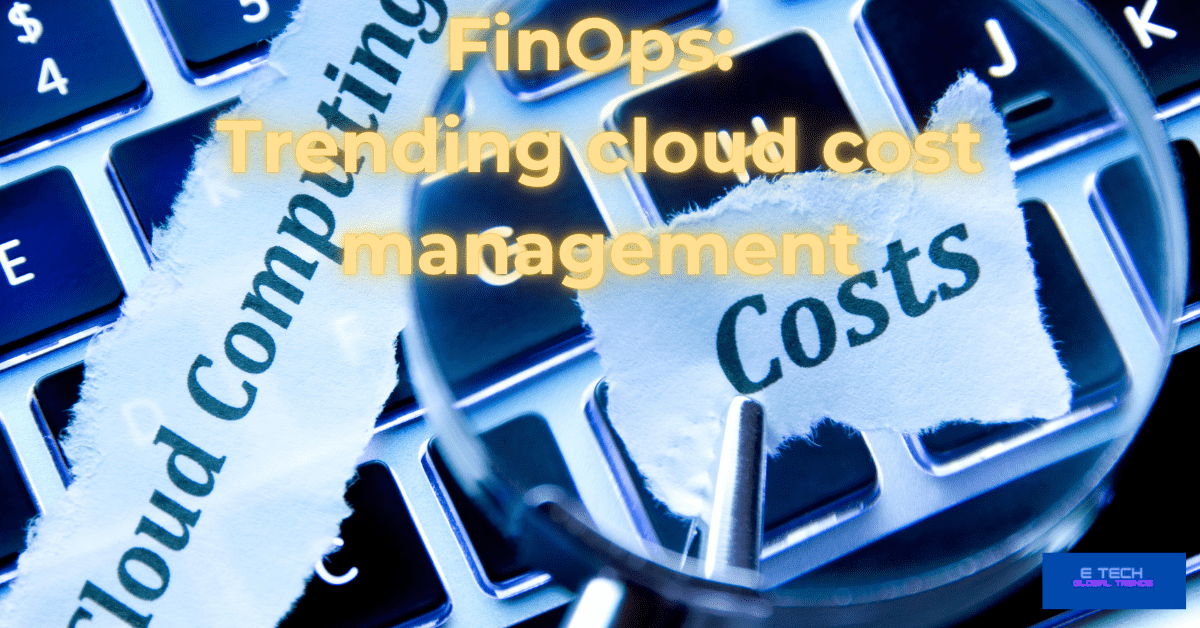FinOps: Trending cloud cost management
Over the past 12 months, searches for “cloud cost management” rose by 125%. as a result of rising cloud computing costs. Approximately 82% of businesses report that the cost of installing cloud technologies ended up being more than anticipated. Furthermore, according to Flexera, 30% of business cloud investment squandered, already. This has increased the demand for tools and techniques for cloud infrastructure management and optimization. So, we decided to discuss “FinOps: Trending cloud cost management”. Let’s get in…
What is Finops?
FinOps is a framework for cloud-based financial management. The management technique known as FinOps, or financial operations, encourages shared accountability for a company’s cloud computing expenditures and infrastructure.
Best practices for finance are recommended for the cloud via the FinOps framework. To maximize the value of your business, you must optimize your cloud spending.
This might involve, among others;
managerial accounting strategies;
- Negotiating prices with your vendors,
- Monitoring and optimizing free trials,
- Checking licenses and use, and
- Estimating expenditures.
In a FinOps framework, teams from buying, finance, and other departments work together with information technology (IT) and DevOps groups to handle cloud expenses throughout the whole enterprise.
Well, really interesting no?
Then is it so important? Of course yes, let’s see how.
The FinOps methodology brings together leadership from the finance, IT, and DevOps sectors to control the overall cost of cloud installations throughout the company.
The company gives cross-functional teams the authority to control cloud expenses while operating according to FinOps principles.
A team or council frequently forms as part of the FinOps initiative to develop governance protocols and enforce industry standards for cloud financial management.
What is the GSDC Foundation?
With regards to new technologies like Blockchain, Six Sigma, DevOps, Cloud, AI-ML, ISO, Agile, and L&D experts, the Global Skill Development Council (GSDC) is an authoritative, vendor-neutral, international credentialing and certification organization.
The GSDC Foundation’s FinOps Practitioner certification was developed to fulfill this need and aid firms in finding qualified individuals.
Sure, is it very difficult? No, it’s a matter of reputation.
Consequently, experts advise pursuing a Finops certificate from GSDC if you’re searching for a better profession.
A candidate’s level of knowledge and comprehension of the advantages of this certification is verified by the Finops certification qualification.
To put it another way, FinOps is a strategy that enables companies to manage and maximize their cloud spending.
Silos between teams inside a firm, according to 68% of organizations, increase cloud spending.
Is cloud spending crucial?
Yes, it is. But it is worth it for utilising resources. FinOps is a new approach that can help to solve this issue. This is so that cross-functional teams may;
- monitor,
- plan, and
- optimize
their use of the cloud, thereby breaking down communication barriers between various teams about cloud utilization.
As a result, cloud costs are reduced as teams are held responsible for their particular usage and expenses.
Implementation of FinOps is still in its early stages; just 15% of firms now have a formal FinOps program. However, FinOps implementation is something that 44% of firms hope to do soon.
Why Finops for cost management?
Engineering, finance, technology, and business teams may work together on data-driven purchasing choices. thanks to the developing cloud financial management discipline. and cultural practice is known as FinOps, which enables enterprises to maximize commercial value.
Advantages Of “FinOps: Trending cloud cost management”
IT professionals claim that switching to the cloud results in savings of around 20%. But not all moves will result in those financial savings.
The businesses that gain the most are those with deliberate financial planning and governance.
In other words, without a competent FinOps organization, your business can be paying for stuff it doesn’t need, unutilized tools, and expired licenses.
Even with the built-in savings of the cloud, if you aren’t paying attention, your expenditure might soar over time. In order to ensure that your teams are receiving the most value for the least amount of money spent, FinOps aims to emphasize constant cloud cost optimization.
Let’s see how. In these aspects- “FinOps: Trending cloud cost management”
- Optimization of cloud costs
- Cost Distribution
- Reliable Prediction
- Licensed professionals with a focus on maximizing cloud use
- Cost transparency
- Finding spending irregularities
- Concrete suggestions for cost-cutting
- Prior to moving to the cloud, make FinOps plans.
- Savings with value
Firstly, what may spring to mind when we discuss cost optimization is maybe saving money.
However, that isn’t really the purpose.
The goal is to maximize the value of your expenditures. FinOps, therefore, involves balancing cost reductions with associated trade-offs rather than just seeking out the lowest choices along the route.
Figure up the organization’s exact expenses.
Understanding your expenditures, both upfront and over time is a crucial first step if FinOps is about being financially responsible.
How come? Let’s see how…
- Experts highly advise pursuing Finops certification if you’re searching for a better career.
- If you’re unsure about where to start, look here. The Finops practitioner certification should be checked next.
- The GSDC website is the recommended source for finops professional certification certifications.
There are not many sources for an online course that offers a recognized certification.
Why not, you can search for it on Google.
Is the cost of certification reasonable?
Finops certification is offered by the GSDC certifying agencies and is recognized across the world.
Many of the workers of well-known companies have completed these courses from here and have positive things to say about the Finops practitioner certification.
You must complete the GSDC Institution’s certified Finops certification online course test to obtain this credential.
The goal of GSDC’s certification is to provide a comprehensive understanding of all advanced Finops professionals.
You must complete the GSDC Institution’s certified Finops certification online course test to obtain this credential.
The goal of GSDC’s certification is to provide a comprehensive understanding of all advanced Finops professionals.
A candidate’s level of knowledge and comprehension of the advantages of this certification is verified by their Finops practitioner certification qualification.
What issues can FinOps address?
Let’s proceed with cost allocation because we previously brought it up. Numerous cloud resources that belong to various assets are either not allocated to them or are assigned to them in the wrong way, which is the first and most common issue that cloud users encounter.
therefore, making it difficult for individuals in charge of creating financial accounts and reports. When connecting cloud cost bills to cost-generating items, cost misallocation causes pandemonium.
What can happen in the implementation
When FinOps is implemented in the business, it makes it easier to determine the department’s or team’s actual efficiency and to determine who is responsible for each line item in the invoice that is paid.
Cloud sprawl that was not foreseen is another issue. The unchecked growth of SaaS instances and cloud providers is referred to as “cloud sprawl.”
Imagine, for instance, that a business employs storage from several sources that are not entirely interoperable or buys more software licenses than is required. Directed to providers results in problems with data consistency; referred to SaaS apps results in waste.
Because of this, it’s critical to understand everything that’s happening in the company’s cloud environment. FinOps seeks to increase cloud asset transparency in order to lower costs and boost overall performance.
Are you an enthusiast regarding FinOps?
Well, no matter what the answer is. We try to make this clear. so; the “FinOps: Trending cloud cost management” informative presentation will make you aware.
Cloud cost optimization: Things you need to know
With compelling justifications, many businesses are fixated on the concept of moving to the cloud. Analyze for yourself: processes that take a lot of time and effort can potentially be automated, and cloud resources can also be simply extended at any moment.
Companies may save maintenance and operating expenses using cloud computing, helping them to stay within their IT budget. It’s not as easy as it appears, though. Without adequate monitoring, it is quite simple to lose focus on resource use rates and build up astronomical cloud costs.
How do we “get in” FinOps?
The vast majority of cloud-focused firms, according to Gartner, experience unforeseen cloud costs. In this situation, establishing a sound cloud cost optimization plan and utilizing cloud cost management solutions is the best course of action.
Many businesses run across an overwhelming number of inquiries while attempting to do this task. In order to assist you in this cloud cost optimization journey, we have addressed the most pertinent of them in this post and offered critical cost-saving suggestions.
1.0 What really is cloud cost optimization?
Reduced total cloud spending is achieved through the process of managing resources and costs known as cloud cost optimization. There are several ways to reduce cloud charges, so you can:
Invest in reserved instances, for instance, to take advantage of savings.
Monitoring cloud resources will help you find and get rid of unnecessary ones, including instances that aren’t being used.
Scale or rightsize cloud resources to fit your needs. Get rid of surplus resources and cut back on those that aren’t being used in order to enhance cloud performance, it is also possible to add more resources.
2. What savings are we eligible for?
To assist consumers lower cloud expenditures, several cloud companies give discounts for ordering resources in advance. Investing in Reserved Instances is the most typical strategy to save money. You purchase them and receive a discount due to a long-term commitment by paying in full up ahead, regardless of actual use.
Reservable computer capacity is provided by well-known public cloud service companies. Instances are the term use when referring to AWS, Azure, and GCP, respectively. Committed Use Discount is the term using when referring to Azure. Users can sign up with any of the three cloud providers and commit to a specified amount of resources for one or three years.
3.0 Do cloud running expenses have any “hidden” components?
Users may access computational resources on demand thanks to the cloud. However, it happens frequently when a business buys resources but then decides not to use them or quits doing so. These resources consume all of your IT money and are completely worthless.
Pay-as-you-go pricing is available from public cloud service providers. Most company owners interpret this as meaning “pay for what you use.” However, with this price structure, you only pay for the items you order. Because of this, it’s simple to accumulate hefty cloud costs for resources, and there is no utilization.
You must first determine which inactive, idle, and underused instances you are being charged for. Review these cases as soon as you find them. There are various options on how to handle them. shut them down, reduce their number, or use their assistance to balance the burden.
4.0 How does scalability affect the reduction of cloud costs?
Horizontal and vertical scaling are the two main methods of scaling in the cloud.
In order to balance the burden, horizontal scaling sometimes referred to as scaling in or out, entails deploying additional instances of cloud resources.
In other words, cloud vertical scaling occurs when a corporation increases the size of an instance by displacing the current one with a larger one. Leveraging up or down is another name for it.
A good technique to save expenses is to rightsize (or scale down). It not only ensures that the workload-appropriate size of the instances of use, but it also saves you from making hasty unneeded resource purchases. It takes place since one of the components of rightsizing is the analysis.
It’s critical to keep in mind that resources, under-provisioned, can also result in delays in addition to those that are over-provisioning. So think twice before you act; consider historical consumption rates as well as potential future traffic variations. The secret to success in this situation is complete visibility.
5.0 How can the business facilitate cross-functional communication?
Using a FinOps strategy is where you might start when establishing communication across teams and departments. In order to maximize the benefits of cloud architecture, it demonstrates how people and technology may work together. It also aids in developing the organization’s cloud strategy and enables employees to communicate in the same language.
By establishing a Cloud Center of Excellence you may address staff inquiries regarding cloud deployment in another way (CCoE). This group of cloud specialists may promote best practices and guarantee the most efficient utilization of the company’s resources.
6.0 How do we calculate cloud cost management for success?
CCoE can assist you with that as well. But what if your organization doesn’t have a Cloud Center of Excellence team? In order to assess your overall cloud performance, we advise taking into account a number of variables.
We separated them into two categories: business and financial issues.
All the considerations that need to make while deploying. and moving to the cloud, including in the financial aspects.
Business considerations offer a more comprehensive perspective on cloud utilization inside the organization since they address cloud agility and performance enhancement issues.
7.0 What resources can I select to reduce my cloud cost management?
If we just list popular options;
Native cloud tools are available from
- AWS: AWS CloudWatch is a monitoring tool provided by Amazon Web Services,
- Azure: Azure Monitor by Microsoft Azure,
- GCP: Google Cloud Monitoring by Google Cloud Platform.
to track and control your expenditures.
What happens if there are many cloud platforms?
When the commitment of the businesses as a single cloud vendor, these solutions are valuable in a single cloud environment. The monitoring procedure, however, can become difficult if the firm uses several cloud platforms and collaborates with numerous cloud providers.
It’s similar to using different wallets to make purchases; it’s difficult or nearly impossible to acquire visibility of your overall expenditure in this scenario.
Users of cloud management systems may have a comprehensive view of all cloud assets in a multi-cloud architecture. Using CMPs makes it simpler to find hidden expenses and utilize your cloud.
Binadox, for instance, provides a Cloud Utilization Dashboard which compiles all the information from a multi-cloud environment to give you a complete insight into all your cloud assets.
8.0 Binadox is a tool for cloud cost optimization.
Businesses may use capabilities from Binadox to monitor and manage various cloud services in SaaS apps and cloud services. so we recommend this also for users who are looking for “FinOps: Trending cloud cost management”- here
Monitoring and analyzing cloud usage rates and expenses are for simpler with Binadox.
- Utilizing the Cost Explorer function, compare cloud charges over a specified time period;
- Find idle, underused, and unused resources;
- To provide more precise cost distribution,
- Tag numerous cloud resources;
- Obtain Rightsizing suggestions depending on the workload at the moment and potential modifications down the road.
Quite a long and in-depth query.
Conclusion:”FinOps: Trending cloud cost management”
To sum up, FinOps as a Service: is a cloud-based service that promotes financial responsibility for a company’s cloud services. FinOps tactics have to be subject gradually. It’s important to have the ground ready in advance to ensure that the procedure goes smoothly. the advice for the Companies is to follow 4 fundamental actions in order to profit from cloud financial management.
Read more on related topics:
GitOps- cloud technology trend,







